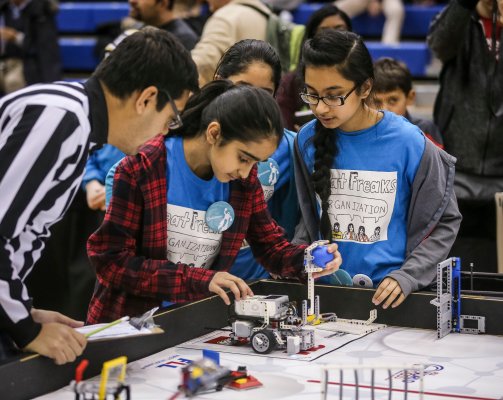While most kids their age are glued to various digital devices, often wasting hours playing mindless games or watching cat videos, 164 fourth and fifth graders, along with eight elementary school teachers, have been using those same devices to explore new paths to learning. In 15 classrooms across Texas and Virginia, students are using manufacturing design and digital fabrication processes to create physical models, learning the underlying mathematical concepts and using them in meaningful contexts.
The FabLab Classroom pilot is a National Science Foundation project focusing on the “E” in STEM education (Science, Technology, Engineering and Math). The project started at the University of North Texas and is based on a scaled-down version of Neil Gershenfeld’s Fab Lab, which originated at Massachusetts Institute of Technology (MIT). Students design their projects in 3D on a computer, then make the item using simple materials.
A wide range of digital tools and facilities available to students and their teachers are transforming the K-12 education system. Fab Labs and makerspaces provide creative areas where kids can design, invent and learn. Video games (e.g. Minecraft) and virtual reality (VR) are being employed as design-based learning tools. 3D printers are more readily available — in schools, in collaborative spaces and at home. All these tools and the widespread commitment to STEM education are introducing kids to 3D design at a very young age.
The focus should be on how schools can help children realize they are not just consumers.
There is no shortage of national interest and enthusiasm for STEM. President Obama believes that more STEM-focused curricula can help rectify America’s education woes and the decline of the American manufacturing industry. Deputy Secretary for the U.S. Department of Education Jim Shelton says, “STEM education is important for every student, no matter what they want to do in life.”
STEM advocates believe this new generation of young people is being inspired by increased access to new kinds of tools, machines and methods. Is it simply the democratization of manufacturing? Or is the maker mindset and further enablement of hands-on, design-based education driving a seismic shift in mentality — from consumer to producer?
Driven by a “sense of agency”
With the shift to offering these tools earlier in a child’s academic journey, we’re not just providing great access to design-based learning, we’re also instilling in students a “sense of agency,” helping them develop their ability to confidently design and create. According to The Harvard Graduate School of Education Agency by Design project:
“A key goal of maker-centered education is to help young people and adults feel empowered to build and shape their worlds. Acquiring this sense of maker empowerment is strongly supported by learning to notice and engage with the designed dimension of one’s physical and conceptual environment — in other words, by having a sensitivity to design. This sensitivity develops when young people and adults have opportunities to: look closely and reflect on the design of objects and systems, explore the complexity of design, and understand themselves as designers of their worlds.”
I see and hear these themes echoed every day in conversations with 3D CAD customers, especially with recent college graduates, but also from our education team that works in the K-12 segment.
Whether it’s labeled STEM or the more encompassing STEAM (add A for Art), students get truly engaged with learning. It’s encouraging to see students inspired by initiatives that bring educational lessons to life, like the new and rapidly expanding Google Expeditions pioneer program, which helps teachers engage students with VR and Google Cardboard. This immersive, 3D experience enables virtual journeys, from the bottom of the sea to the surface of Mars.
Through FIRST Robotics competitions, more than 78,000 students in the U.S. are active participants in what the Agency by Design espouses as “sensitivity to design.” These students make real-world calculations to build robots that are capable of scooping up and shooting balls, jumping over obstacles or making other seemingly impossible moves, all in a maker spirit that weaves together the numerous disciplines of STEM learning.
According to The 74, a nonprofit, non-partisan news site covering education in America, the Bricolage Academy of New Orleans has something missing in its classroom: chairs. In his recent piece, The Maker Movement Is About More Than Science and Math — But Is All This Tinkering Really Effective?, Mark Keierleber writes, “Instead of sitting with paper and pencils at desks, students stand at work tables and tinker with LEGOs, robots, wooden blocks, and circuit boards.”
Kids at the Bricolage Academy, along with those 164 students in Texas and Virginia, are just the tip of the iceberg. That iceberg is upending and bringing millions more students to the surface as they start to experience the power of STEM, the maker movement and new methods of teaching like blended and personalized learning.
These students and teachers may not use the same language as President Obama, the Department of Education or the Agency by Design project, but the message is the same: “I want to learn how to create something amazing.”
It isn’t just technology, or a STEM focus, or even a maker mindset; instead, the focus should be on how schools can help children realize they are not just consumers — they are designers, creators, makers and producers. Today’s fifth graders will be lifelong STEM learners.
